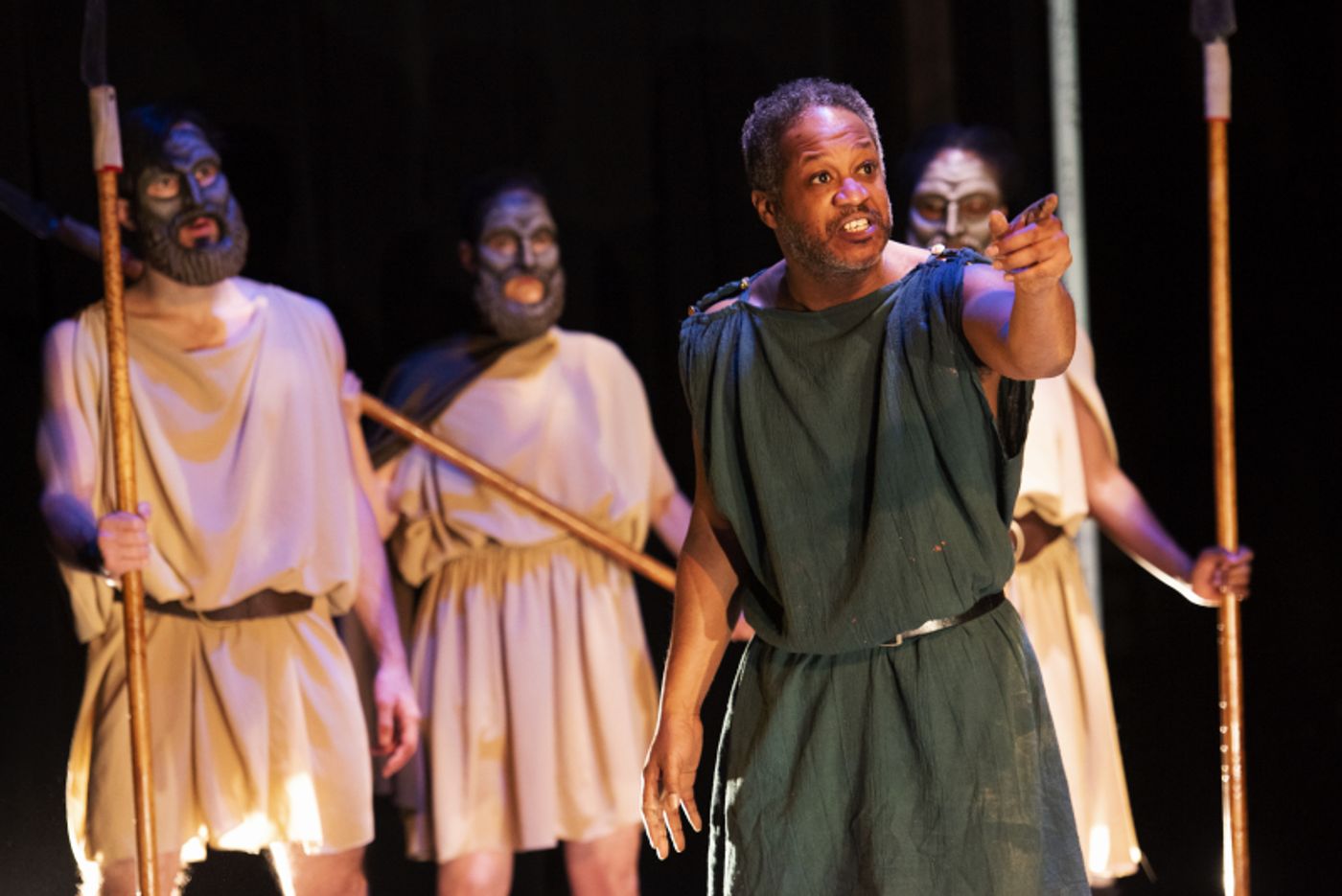Review: The Cure at Troy at Quintessence Theater
Seamus Heaney's retold classic on stage at Quintessence Theater through February 20

Co-authored with Carson Schatzman, a Philadelphia-based writer and creative.
A modest audience was drawn into the reeks and roars of a rare production of Seamus Heaney's The Cure at Troy on Saturday night around the intimate, runway-style stage at Quintessence Theater in Philadelphia. The retelling of Sophocles's Philoctetes prospered under the direction of Alexander Burns, with actor Steven Anthony Wright leaving a definitive stamp on a challenging role as the savaged Philoctetes.
First produced in 1990, The Cure at Troy is an unusual gift to the theatrical world by the late, decorated Irish poet. As the story goes, a decade into the Greeks' prolonged siege of Troy, the shrewd Odysseus (Joseph Langham) arrives on the island of Lemnos with young Neoptolemus (Jo Vito Ramirez), the son of the slain hero Achilles lured into the immortal war by the promise that he alone holds the key to a Greek victory.
Here, Neoptolemus learns the troubling story of the island's sole, stranded inhabitant, the archer Philoctetes, abandoned there by Odysseus himself on the outbound voyage to Troy after Philoctetes's snakebitten foot putrified so horrendously that the smell of the pustulating ulcer set shipmates vomiting into the sacrificial relics. The decision, however, turned out to be regrettable. After consulting an oracle to learn that the sole path to victory lies through the return of Philoctetes and the magical bow he wields, Odysseus voyaged to the infamous Volcanic Island to beguile the wounded archer by proxy - his instrument of choice, the impressionable Neoptolemus, who is tasked with deceiving the archer and absconding with the bow.
The text itself enjoys Heaney's modern poetic instincts while recalling the structure of the original Greek at impactful moments, drawing the audience into a logical language employed to resolve dilemmas that elude reason, turning instead on personalities and passions.
Wright's Philoctetes exudes intensity from the moment his wails enter the stage before his own wildish figure, affecting the adjustments of a stranded man reacclimating to human conversation, his unpredictable cadence carrying both suspicion and desperation, as well as the light insanity of one accustomed to talking with themself alone.
He snarls and spits as he totes his bandaged foot, which quivers when it encounters too much pressure. Sweating, swallowing, gripping his bow, he is every moment grappling with his wound, and with the wounded dignity and trust that bleed just as deeply. When overtaken by paroxysms of pain, his agonized cries spur climactic character moments that could have fallen flat with anything less.
On the receiving end of these moments, Neoptolemus encounters a moral dilemma between duty to his army and his commander, Odysseus, and his pity-born friendship to Philoctetes. At least, that's how the classical story goes. Evidently more single-minded, Ramirez's Neoptolemus runs in a single register. Wide-legged, head habitually protruding six inches beyond their body, their delivery tends toward grandiosity where one might expect a more conflicted, developing tone.
With energy that borders on smugness, this Neoptolemus exudes the unreflected confidence of youth born to a noble name. It can be difficult to trace his inner conflict at times, or to find the beats of percolating character development amid the persistent externalization. For him, it seems, even the wounds of youth don't scar, but only need a thorough airing out.
The Chorus, embodied by Leah Gabriel, Eunice Akinola, and Michael Liebhauser, is admirably harmonized, expressing their unity in stance and delivery. Their voices, euphonic and practiced, hang together well and fill the room with the strangeness of the classical fixture, culminating in an impressive penultimate scene where lines are expertly layered and reinforcing. Lighting and sound design from Burns and John Burkland come in strong here, opening up ample space in the sandy strip of stage for the play's big moments.
Reprised and performed nearly two and a half millennia after the original, the play leaves us contemplating the weeping of historical wounds. Burns reported in an informal interview that he had an eye toward our own sociopolitical moment when he chose to produce a play about healing, one where the wounded party undergoes the painful process of coming to terms with the violence experienced at the hands of their own countrymen in order to move forward and become the force that ultimately saves them. In our view, the chance to draw on the lessons of literature is well worth pondering with the Quintessence troupe.
The Cure at Troy runs until February 20, with show info and tickets available at https://www.quintessencetheatre.org/thecureattroy or by phone at. Proof of vaccination is required for entry, and streaming options will be available for ticket-holders unable to attend in person. Given the theater's safety precautions, we'd recommend catching this performance up close, where we'll wager your skin will prickle more than once.
More safety details are available at https://www.quintessencetheatre.org/healthandsafety.
Reader Reviews
Videos

